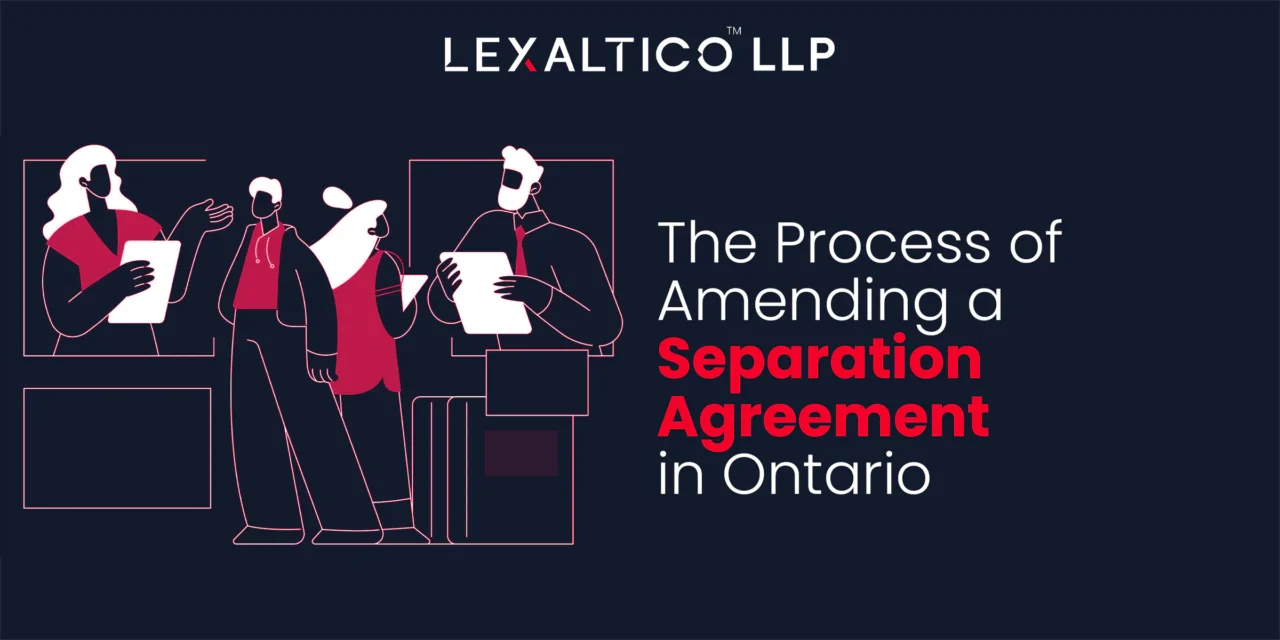A separation agreement is a legal contract that outlines the terms of a separation, including issues such as child custody, property division, and spousal support.
However, life circumstances can change anytime and those changes may require revisions to the original agreement. If you have remarried or relocated, amending your separation agreement becomes an important step to make changes to new setting.
In Ontario, the process of changing a separation agreement involves assessing the need for amendments, negotiating those changes, making the amendments, and legalizing the new agreement. So that both parties agree to the changes and that the amended agreement is enforceable under Ontario law.
Amending a Separation Agreement in Ontario

Changing a separation agreement in Ontario follows a step-by-step process.
1. Deciding If Changes Are Needed
Look at the current agreement:
Read the agreement carefully to see if anything no longer works. Common reasons include remarriage, moving to a new city, or changes in income or child care.
Get legal advice:
Talking to a family lawyer is strongly recommended. A lawyer can explain how changes might affect you and make sure everything follows Ontario law.
2. Talking About the Changes
Communicate clearly:
Both sides should discuss changes openly and try to agree in a fair way.
Use mediation or lawyers if needed:
If you can’t agree, a mediator (a neutral third person) can help both sides find common ground. Each person can also have their own lawyer to protect their rights during these talks.
3. Writing the Amendment
Follow legal rules:
The new amendment must be written clearly and in line with Ontario’s laws. It should say exactly what parts of the old agreement are being changed.
Be specific:
The document should list the new terms in plain language so there’s no confusion later.
4. Signing and Making It Official
Signing and witnessing:
In Ontario, the amendment must be in writing, signed by both people, and witnessed by an adult who is not part of the agreement. Without this, the amendment is not valid.
Filing (sometimes needed):
You don’t have to file the amendment with a court for it to be valid. But you must file it if:
- you want it enforced as a court order (for example, through the Family Responsibility Office for child or spousal support), or
- you are changing a court order or an agreement that is already filed in court.
This is especially important if changes affect child custody, support payments, or other key matters.
Step-by-Step Court Process (Motion to Change)
If your separation agreement was filed with the court, or you already have a court order, and you need to change terms like support or parenting, you may need to start a Motion to Change. This is the formal process the Ontario family court uses to update existing orders or filed agreements.
When Do You Need a Motion to Change?
A Motion to Change is usually needed when you want to:
- Change child or spousal support (amounts or duration).
- Change decision-making responsibility or parenting time.
- Update contact arrangements for children.
- Modify a final order, a temporary order, or an agreement that has already been filed with the court.
If both parties agree to the new terms, you can use a Consent Motion to Change instead. This makes the process faster and avoids a full court hearing.
Key Forms and Timelines for a Motion to Change in Ontario
| Form | Purpose | When It’s Needed | Timeline |
|---|---|---|---|
| Form 15: Motion to Change | Starts the process | Always required to ask the court for changes | Filed at the start |
| Form 15A: Change Information Form | Gives details about what you want changed | With Form 15 | Filed at the start |
| Form 15B: Response to Motion to Change | Other party’s reply | If the other person wants to respond | Within 30 days (or 60 days if outside Canada/US) |
| Form 15C: Consent Motion to Change | Both parties agree to changes | Use for any agreed-upon changes | Filed with court once signed |
| Form 15D: Consent Motion (Child Support Only) | Both agree to change child support | Use when only child support is being changed | Filed with court once signed |
| Form 13: Financial Statement | Lists income, expenses, assets, debts | Needed if changes involve support | Filed with motion |
| Form 13.1: Financial Statement (Support & Property) | More detailed version of Form 13 | Needed if support and property issues are involved | Filed with motion |
| Form 35.1: Parenting Affidavit | Explains parenting/decision-making details | Needed if parenting or custody is being changed | Filed with motion |
| Form 6B: Affidavit of Service | Proof the other party was served | Always required after serving documents | Filed after service |
Court Review and Outcomes
After documents are filed and served, the court may:
- Approve your agreement if both sides consent.
- Hold case conferences or hearings if you don’t agree.
- Make temporary or final orders.
- Ask for more financial disclosure.
- Set timelines for next steps.
The outcome will depend on whether you and the other party can agree, and what the judge believes is fair under Ontario family law.
Legal Considerations and Compliance

Amending a separation agreement requires attention to legal details to ensure that the changes are enforceable under Ontario law.
The following points are important to keep in mind when navigating the legal requirements.
1. Legal Principles Governing Separation Agreements
Separation agreements in Ontario are governed by several legal principles, including:
- Full and Frank Disclosure: Both parties are required to fully disclose their financial situations. This transparency ensures that decisions made regarding child support, property division, and other financial matters are informed and fair.
- Independent Legal Advice (ILA): While not a legal requirement, it is strongly recommended that each party seek independent legal advice. ILA ensures that each party understands their rights and obligations under the agreement and any amendments.
- Voluntariness: A separation agreement, including any amendments, must be entered into voluntarily, without coercion or undue influence.
2. Importance of Legal Advice in Ensuring Compliance
Legal advice is crucial to ensure that the amended agreement complies with Ontario’s legal standards. A family lawyer can:
- Review the proposed changes to ensure they are legally valid.
- Advise on the potential implications of the amendments for each party’s rights and obligations.
Assist with drafting the amendment to ensure it is comprehensive and clear. - Guide parties through the legal process, including the signing and, if necessary, filing of the amendment with the courts or other relevant authorities.
3. Enforceability of Amended Agreements
For an amended separation agreement to be enforceable in Ontario, it must meet specific conditions:
- Written and Signed by Both Parties: The agreement must be in writing and signed by both parties. It should also be witnessed to ensure its legal validity.
- Legal Compliance: The agreement must comply with all the legal principles governing separation agreements and must not contain terms that violate public policy or are illegal.
4. Potential Challenges and How to Address Them
Despite best efforts, challenges may arise regarding the enforceability of an amended separation agreement. These challenges can include allegations of undue pressure, lack of full disclosure, or claims that the agreement is overly unfair to one party.
To minimize these risks:
- Ensure full and frank disclosure of all relevant financial information.
- Seek independent legal advice to ensure both parties fully understand the agreement.
- Document all negotiations and the reasons behind the amendments to establish that the agreement was entered into voluntarily.
Practical Tips for a Smooth Amendment Process
Even though changing a separation agreement involves legal steps, there are also simple things you can do to make the process easier.
1. Communicate Clearly
Talk openly and use neutral words. Listen to each other’s concerns and be honest. This helps avoid misunderstandings and keeps the discussion respectful.
2. Keep Records
Save all messages, emails, and notes from calls or meetings about the changes. Having records makes it easier to show what was discussed and agreed upon.
3. Get Professional Help if Needed
- Lawyers: If the changes are complicated or one person feels unprotected, a family lawyer can give advice and make sure the new terms follow Ontario law.
- Mediators: If it’s hard to communicate, a mediator can guide the conversation and help both people reach a fair agreement.
- Financial Advisors: If the changes involve money issues, like support payments or dividing property, a financial advisor can help sort things out.
Conclusion
Changing a separation agreement in Ontario because of remarriage, moving, or other life changes needs to be done carefully. The changes must be fair, legal, and enforceable. This can be done if both people agree, or, in some cases, through the court.
Getting legal advice and being open with each other during the process helps prevent problems in the future.
Quick FAQs
You can amend your separation agreement after remarriage or relocation in Ontario if both parties agree to the changes or if the court approves the amendments.
An amendment must be in writing, signed by both parties, and meet the legal requirements set by Ontario law to be considered valid.
Both parties must mutually agree to any changes in the separation agreement for the amendment to be legally binding.
Amendments can be made without going to court if both parties agree to the changes and the necessary documentation is completed correctly.
Motion to Change (Form 15): If there is already a court order (or an agreement filed with the court for enforcement) and you need to change support, parenting time, or decision-making responsibility, you use Form 15: Motion to Change (or Form 15D/15C for consent changes).
A Motion to Change is typically required for modifications to support terms, while changes to other agreement terms may be made through mutual consent or different procedures.
Moving or remarrying can impact the terms of your separation agreement, such as custody, support, or other arrangements, and may require amendments to reflect the new circumstances.
It is highly recommended to seek legal advice when making amendments to ensure the changes comply with the law and that both parties’ rights are protected.
Parties can resolve changes through mediation or family arbitration and then sign an amending agreement. Courts generally respect properly made ADR outcomes, and arbitration clauses in separation agreements are enforceable.
To amend a separation agreement through the court, you will need to complete and file Form 15 (Motion to Change) and potentially Form 13 or 13A (Financial Statement), depending on the changes.
Disclaimer: The information provided in this blog is for general informational purposes only. It is not legal advice and should not be relied on as such



